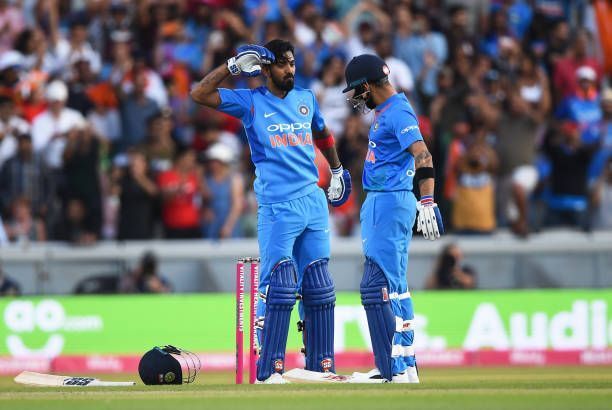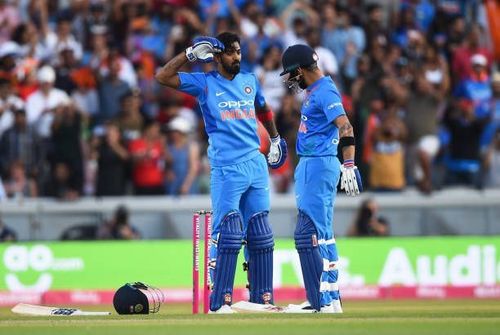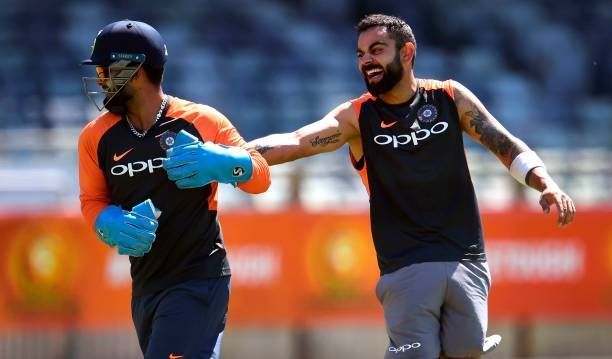
The solution to India’s middle order conundrum might be within the team itself

As Pat Cummins steamed his way towards the crease and produced some lateral, inward movement, Ambati Rayudu lost his balance, squared himself up and eventually got bowled, looking more puzzled than disappointed. One may see it as an exceptional delivery, and Cummins, on his good days is quite capable of doing so.
However, an Indian number four batsman, who is supposed to steer the innings when asked for and accelerate according to the situation, should have approached that with better technique and stayed on the crease longer.
After all, it was one of the rare days that the Indian bowling unit hadn’t restricted the opposition to a sub-par total, and hence the importance of the crucial number four batsman became even more prominent, especially when both your openers are out before the end of the power play. Make no mistake, Rayudu has done fairly well in given opportunities, and even saved the side from an embarrassing collapse at Wellington in the fifth ODI against New Zealand last month.
His innings of 90 runs would have come as a breath of satisfaction for the team management, but the problems for the Indian team seem to be arising with the World Cup looming larger than ever now.
An ideal number four batsman should arguably be the pillar of the team, as he would have three batsmen above and below him to do the scoring according to the situation. He should act as a pillar of solidarity in the hour of need, avoiding the fall of wickets or accelerating the flow of runs by assessing the situation accurately.
Ross Taylor, as an example, is the closest who comes to that category and fulfills all these criteria properly. For India though, the dominance of their top three have made them ignore the fragility of what is supposed to be their pillar of the batting order.
After having tried out close to a dozen batsmen in that crucial fourth slot since the 2015 World Cup, the team seemed to have zeroed in on Rayudu as their solution before the series against West Indies. But, what was the parameter of that decision?
Rayudu had failed the fitness test before the England tour and played as a number three in most of the matches in the Asia Cup. Then, was it enough exposure for him to be finalized as the sole holder of that spot in the team? Despite Rayudu’s obvious strengths against the spinners, it seemed more of a decision taken in haste, rather than having a patient watch before making the final call.
On the other hand, the management was keen to see how Rayudu does after getting full backing from them, which is a fair decision as well. But, here now, India stand with two ODIs in front of them and still a lot of cloud of doubt over what could possibly be the solution to their worrisome number four position.
Thankfully, the nature of Indian team has been so that any new player or someone who has been in the squad but not in the playing XI has shown the ability to slot into that position in lesser time than one would initially presume.
Virat Kohli further insisted that he would not want to see any more collapses whilst batting, and hence changes now just seem to be a formality. As aforementioned, a number four player needs to be adept at reading the game situation, so as to know at what pace the inning needs to be steered.
And no one comes close to analyzing the game situation as MS Dhoni and Kohli himself in international cricket. One of the major reasons for their incredible success whilst chasing has been their ability to gauge the scenarios and strike their blows astutely.
They know how to run an innings, take their partners along through it and then finish it off calmly too. Rohit Sharma said after the first ODI in Australia in January that he thinks that Dhoni’s best batting position is to come at two wickets down. He scored an unbeaten 87 in the series-decider at Melbourne a couple of months ago, after having come to bat with two wickets down.
Now, being the vice-captain, Sharma should surely be a part of the leadership and the decision-making group. However, Kohli seems to differ with him for understandable reasons. India’s batting in the last few years has been top heavy and the captain obviously trusts Dhoni to act as the stabilizer in the middle order.
Credit to the veteran himself; he has carried out this role very well since the turn of the year. And given how Dhoni has managed to brush aside recent collapses, it is a growing consensus that the 37-year-old would augur well at number five. His calming influence has been often understated in recent times, but kudos to the management for having persisted, supported and then reaped the benefits from Dhoni’s contributions. Hence, him moving up to number four does not seem possible.
So, the next option is arguably the captain himself. Kohli has recently stated that his style of play suits well for both number three and four positions. To be honest, it is true as well. His tendency to accurately pace an inning in seconded by none, barring Rohit Sharma to some extent. He is undoubtedly the strong from a technical perspective, and can see off seaming conditions by stopping the fall of wickets from one end. Moreover, his biggest strength is his ability to score at an excellent rate by taking minimal risks.
Kohli always keeps the scoreboard ticking and the asking rate is never beyond reach until he is at the crease. One of the major qualities of a number four batsman must be that he should be equally adaptable to different scorelines, be it 20/2 or 220/2. One would rather argue that Kohli has been used to setting the pace of the innings rather than following the pace of it.
However, the 30-year-old is the only one who could blend himself to any given situation without disturbing his natural approach towards the game. This opens up an opportunity to play KL Rahul as the number three batsman. Rahul has recovered decently since joining the India A camp for the series against England.
He scored some crucial knocks as the captain in those two unofficial test matches and was in fine form in the T20I series against Australia as well.

The Indian batting approach has become too radical at times and needs a bit of freshness, unorthodox outlook to restructure their perspective and reduce their over-dependence on the trio of Sharma, Kohli and Dhoni. In all fairness,
Rahul’s limited overs capabilities shouldn’t be doubted, and hence the KXIP opener deserves a run in the playing XI, as most of the times he has had to sit out because the team did not want to tinker with the opening combination of Sharma and Shikhar Dhawan.
The latter has been consistently incredible in ICC tournaments but his recent form has been astonishingly poor by his own standards and causes another concern before the mega tournament. The World Cup is going to be a long tournament and wouldn’t there come a situation where the team would want to change the opening partnership due to various reasons?
In that case, Rahul can bat at his preferred opening position, but that would also mean that Kohli will bat at the usual number three slot too. Rishabh Pant could be another option to play at two-down in such a scenario. Pant has proven his worth in Tests but his prolonged run of poor form in T20Is has left the masses scratching their heads.
After all, that is the format which shot him to fame, through the IPL. However, given the natural talent that he possesses, it would be unfair on him to be written off from the limited overs perspective. An advantage is the fact that is a southpaw. Most of the teams like to operate with leg-spinners in the middle overs, as they have consistently delivered with more wickets than their off-spin counterparts.
Pant can take on the opposition in such scenarios, given his proficiency in playing wrist spinners. They give him a chance to hit through his natural angle and that could help the team up the ante during the middle overs. One of Pant’s major problems has been his tendency to unnecessarily opt for certain shots when the situation demands lesser pigheadedness.
However, if he plays at number four, then he would be flanked by Kohli and Dhoni on either side. Newcomers often tend to adopt a more sensible batting approach whilst playing with experienced teammates and this could help his pace and thereby structure his innings more calmly.
To conclude my points, it is necessary to accept that India’s batting approach might need a bit of rejig, and that needs to be done at the top of the order and not by playing an extra all-rounder, which would subsequently weaken the bowling attack.
Their batting attitude needs some tweaks and that could be done by introducing the likes of KL Rahul and Rishabh Pant in the playing XI. Both of these lads are immensely talented but have had some poor matches. However, if one wants to make a fair assessment of their talent, they need to only go back to the Trent Bridge Test match in September when they together took apart a potent England bowling lineup. Rahul’s century at Manchester in the first T20I last year is one to be remembered for ages too.
Hence, if given proper roles, they could also instill the required attacking approach in India’s current batting lineup.
But, if the team decides to persist with the regular opening combination, then Kohli could be an ideal number four batsman to engineer India through certain important phases of the inning. However, it is necessary to have either one of Rahul or Pant in the top six to help solve a worrying issue of the middle order. If they find a way to fit both of them in, the results could see a dramatic change too.
Therefore, it is safe to say that the solution to India’s middle order conundrum might be within the team itself, but they would have to be open to experiment and tweak with their fixed, rigid approach at times.